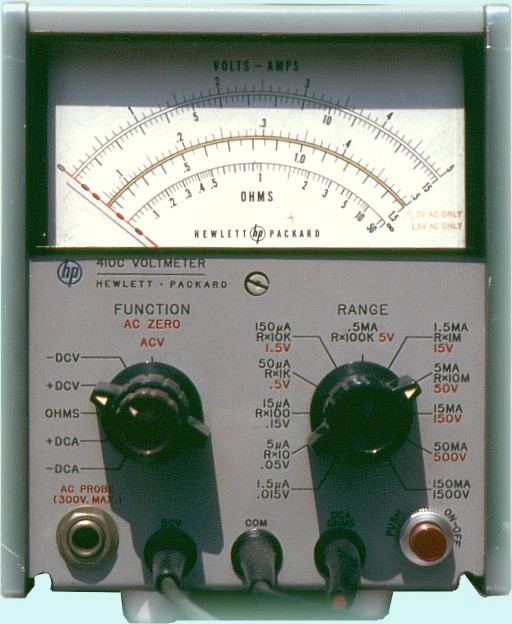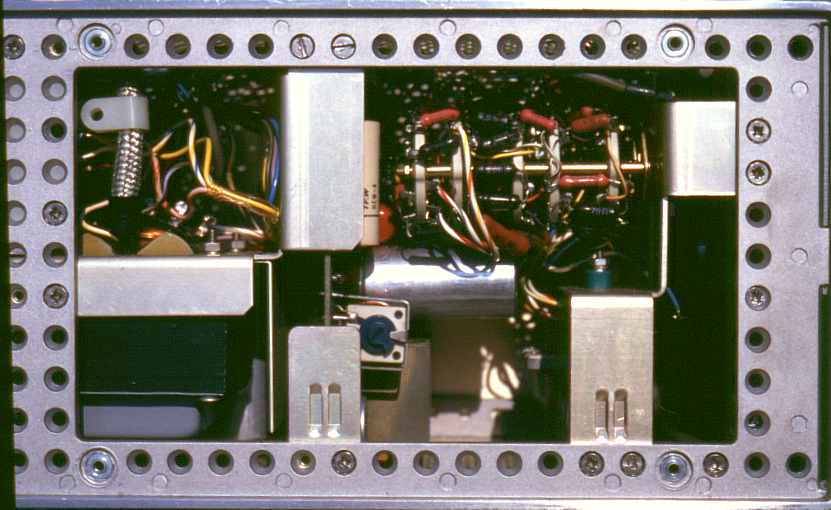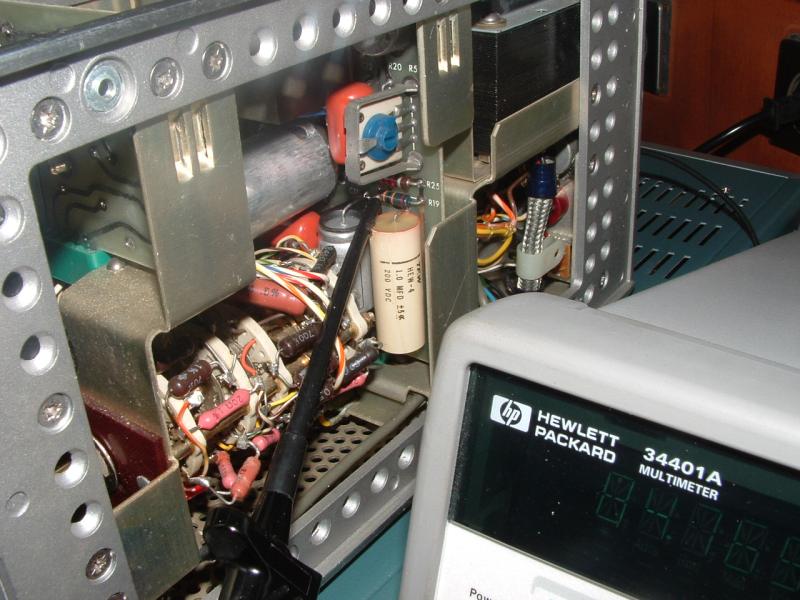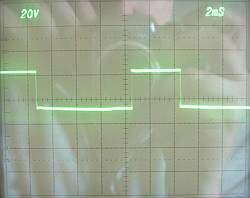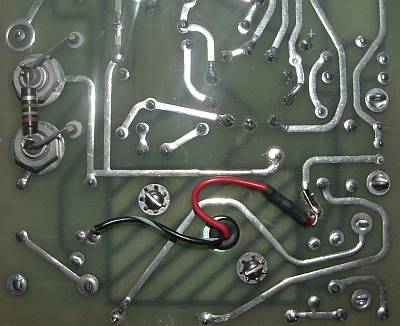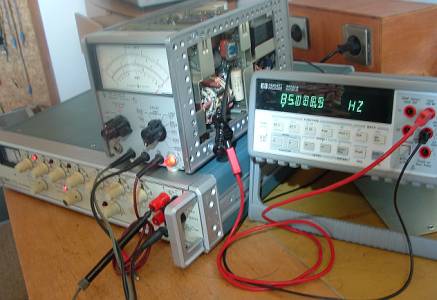410C Electronic Voltmeter
Das HP 410C ist ein elektronisches Voltmeter gebaut in den 60zigern.
Eine Besonderheit es können bis zu 700 MHz gemessen werden.
Allerdings benötigt dies einen externen Röhren
Tastkopf. Eine Gleichrichter Röhre, die mit ihrer
Wärme bei kaltem Wetter schön die Finger
wärmen kann. Auch
heutzutage noch von Nutzen der hohe Messbereich bis 1500 VDC und der
kleinste Strombereich bis 1,5 µADC.
The
HP410C is an electronic voltmeter build in the sixties. Can measure up
to 700 MHz with an external tube rectifier probe. Nice to warm your
fingers in the wintertime. Unfortunately missing probe with this
device. Even nowadays useful the 1500 VDC range and the 1.5
µADC current range.
Specification
DC
VOLTMETER
-
Voltage
Ranges: ±15 mV to ±1500 V full scale in 15, 50
sequence (11 ranges).
-
Accuracy:
±2% of full scale on any range.
-
Input
Resistance: 100 megohms ±l% on 500 mv range and above.
-
10
megohms ±3% on 15 mV, 50 mV, and 150 mv ranges.
DC AMMETER
-
Current
Ranges: ±1.5 µa to ±150 mA full scale
in 1.5, 5 sequence (11 ranges).
-
Accuracy:
±3% of full scale on any range.
-
Input
Resistance: Decreasing from 9 K ohms on 1.5 µa scale to
approximately 0. 3 O on the 150 ma scale.
-
Special
Current Ranges: ±1. 5, ±5, and ±15
nano-amps may be measured on the 15,
50, and 150 millivolt ranges using the voltmeter probe, with
±5%
accuracy and 10 megohm input resistance.
OHMMETER
-
Resistance
Range: Resistance from 10 ohms to 10 megohm center scale (7 ranges).
-
Accuracy:
Zero to midscale: ±5% of reading or ±2% of
midscale, whichever is
greater. ±7% from midscale to scale value of 2.
±8% from scale value of
2 to 3. ±9% from scale value of 3 to 5. ±10% from
scale value of 5 to
10.
AMPLIFIER
-
Voltage Gain: 100 maximum.
-
AC
Rejection: 3 db at 1/2 cps; approximately 66 db at 50 cps and higher
frequencies for signals less than 1600 v peak or 30 times full scale,
whichever is smaller.
-
Isolation:
Impedance between common and chassis is >10 meg in parallel with
0.
1 µf. Common may be floated up to 400 v dc above chassis for
dc and
resistance measurements.
-
Output:
Proportional to meter indication; 1. 5 v dc at full scale, maximum
current, 1 ma.
-
Output
Impedance: Less than 3 ohms at dc.
Noise:
Less than 0. 5% of full scale on any range (p-p).
AMPLIFIER
(Cont'd)
DC
Drift: Less than 0. 5% of full scale/year at constant temperature. Less
than 0.02% of full scale
-
Overload
Recovery: Recover from 100:1 overload in <3 sec.
AC
VOLTMETER
-
Ranges:
0. 5 v full scale to 300 v in 0. 5, 1.5, 5 sequence (7 ranges).
-
Accuracy:
±3% of full scale at 400 cps for sinusoidal voltages from 0.
5 to 300 v
rms. The AC Probe responds to the positive peak-above-average value of
the applied signal.
-
Frequency
Response: ±2% from 100 cps to 100 Mc (400 cps ref.)
±10% from 20 cps to 100 cps and from 100 Mc to 700 Mc.
-
Frequency
Range: 20 cps to 700 Mc.
-
Input
Impedance: Input capacity 1. 5 pf, input resistance >10 megohms
at
low frequencies. At high frequencies impedance drops off due to
dielectric loss.
-
Safety:
The probe body is grounded to chassis at all times for safety. All ac
measurements are referenced to chassis ground.
-
Meter:
Individually calibrated taut band meter. Responds to positive
peak-above-average. Calibrated in rms volts for sine wave input.
GENERAL
-
Maximum Input: (see Overload Recovery)
-
DC: 100
v on 15, 50, and 150 mv ranges; 500 v
-
on 0. 5
to 15 v ranges; 1600 v on higher ranges. AC: 100 times full scale or
450 v peak, whichever is less.
-
Power:
115 or 230 v ±10%. 50 to 1000 cps, 13 watts (20 watts with
11036A AC Probe).
-
Dimensions:
6-1/2 in. high (16.5 cm); 5-1/8 in. wide (13.01 cm); 11 in. deep (27.9
cm) behind panel. Fits 5060-0797 Rack Adapter and 1050 series combining
cases.
-
Weight:
-
Net: 8
Ibs. (4,0 kg).
-
Shipping:
approximately 14 Ibs. (6,35kg).
-
Accessories
Furnished: Detachable power cord, NEMA plug; Model 11036A AC Probe.
-
Option
02: Model 410C less AC Probe.
Kalibration
Zuerst wurden die Gleichrichterkondensatoren geprüft, es sind vier
in Reihe mit Widerständen geschaltete Elkos. Alle Elkos sind in
einem Rund Gehäuse. Es wurde etwas Kapazität draufgelegt,
zumal am ersten Elko ein Ripple von ca. 20 Volt zu finden war, jetzt
ist Ruhe.
Nach einer ausgiebigen Reinigung bot es sich an das Gerät auch
frisch zu kalibrieren. Ich habe das originale Handbuch, es ist gut
beschrieben, Kopien sind über Suchmaschinen zu finden.
Zuerst die mechnische Nullpunktkorrektur, gefolgt von der elektrischen.
Ein Problem hatte die Einstellung, der Zeiger flackerte leicht um den
Messwert herum, er ozillierte, ansonsten lief das Gerät.
Hier wurde die Modulator und Demodulator Frequenz eingestellt. Der
blaue Trimmer stellt sie ein, für Deutschland mit 50Hz Versorgung
ist der Trimmer auf 85Hz einzustellen, für 60Hz Netze auf 100Hz.
Die Anschlüsse sind dabei wie folgt:
Frequenzzähler 34401A GND and den 410C REAR Output GND.
Frequenzzähler 34401A INPUT and den 410C Widerstand R19 linker Draht
410C auf DC+, 15mV Range
410C an Input und GND 5VDC anlegen, der Verstärker wird dadurch
übersteuert, am R19 erscheint eine Wechsspannung mit der Modulator
Frequenz.
Spannung am R19 während der Frequenzeinstellung. Mit dem blauen
Trimmer im erwärmten Zustand auf 85Hz +/-1Hz einstellen. Der
Zeiger hat nach der korrekten Frequenzeinstellung aufgehört zu
oszillieren. Die Leiterplatte gehört zum Verstärker auf dem
auch der blaue Trimmer montiert ist. Leider war es nicht mehr
möglich mit dem Wertebereich des 40k Trimmers die 85 Hz
einzustellen (die 100 Hz wären möglich gewesen). Der Trimmer
stand am Anschlag bei etwa 93Hz. Das Nachmessen des Trimmers hat
32k als Maximalwert ergeben, so lötete ich zusätzlich 15k mit
in Reihe zum Trimmer. Der 15k Widerstand sitzt am roten Kabel unter dem
Schrumpfschlauch.
Anschließend erfolgt noch die Gain Kalibration im 15mV Bereich.
15mV anlegen und den Gain Trimmer auf Vollauschlag trimmen, die
Sollwerte werden dem Gleichspannungskalibrator entnommen. Danach ein
Abgleich mit 300V und ein paar weitere, sowie der AC Bereich
bei vorhandenem Tastkopf. Je nachdem wie lange man eine Warmlaufphase
gönnt, dauert das Einstellen bei intaktem Gerät etwa 1 Stunde.
